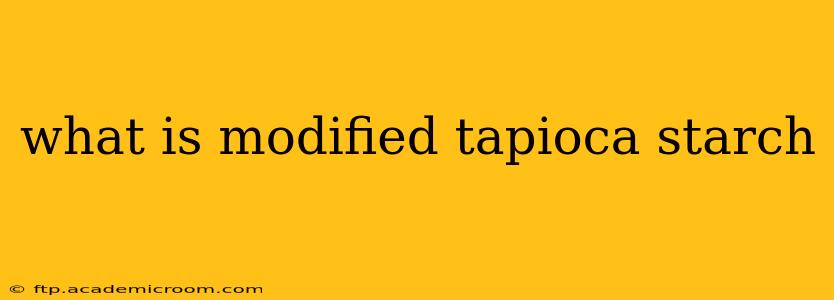Modified tapioca starch is a versatile ingredient used extensively in food processing and other industries. It's derived from the cassava root (also known as yuca or manioc), a starchy tuber widely cultivated in tropical regions. Understanding its properties and uses requires delving into its processing and functionalities. This article will explore modified tapioca starch in detail, answering common questions surrounding its production, applications, and benefits.
How is Tapioca Starch Modified?
Tapioca starch, in its natural form, has certain limitations in terms of its functionality. Modifications are made to enhance its properties, such as improving its viscosity, stability, texture, and clarity. These modifications are achieved through various physical, chemical, or enzymatic processes. Common modifications include:
- Acid Modification: Treating the starch with acids like hydrochloric acid alters the starch molecules, leading to increased viscosity and clarity.
- Enzyme Modification: Enzymes are used to break down some of the starch molecules, resulting in lower viscosity and improved freeze-thaw stability.
- Cross-linking: This process involves chemically linking starch molecules together, enhancing its strength and resistance to shear, making it ideal for applications requiring high stability.
- Hydroxypropylation: This chemical modification improves the starch's solubility and resistance to retrogradation (the process where starch molecules recrystallize, leading to undesirable texture changes).
What are the Properties of Modified Tapioca Starch?
The specific properties of modified tapioca starch depend on the type of modification used. However, some common advantages include:
- Improved Viscosity: Modified tapioca starch offers superior thickening power compared to native tapioca starch.
- Enhanced Texture: It can create smoother textures and improved mouthfeel in food products.
- Increased Stability: Modifications enhance resistance to temperature changes, shear stress, and freeze-thaw cycles.
- Better Clarity: Some modifications produce clearer solutions, desirable in many applications.
- Improved Water Binding Capacity: Modified versions often exhibit better water retention capabilities.
What are the Uses of Modified Tapioca Starch?
Modified tapioca starch's versatility extends across various industries, including:
- Food Industry: It serves as a thickener, stabilizer, binder, and texturizer in a wide range of food products, including sauces, soups, gravies, processed meats, baked goods, confectionery, and dairy products.
- Paper Industry: It's employed as a coating agent, improving paper strength and surface properties.
- Textile Industry: It's used as a sizing agent in textile manufacturing, providing strength and protection to fibers.
- Pharmaceutical Industry: It can act as a binder and disintegrant in tablet formulations.
Is Modified Tapioca Starch Gluten-Free?
Yes, modified tapioca starch is naturally gluten-free, making it a suitable ingredient for individuals with celiac disease or gluten intolerance. However, always check the product label to ensure that no cross-contamination has occurred during processing.
Is Modified Tapioca Starch Safe to Eat?
Modified tapioca starch is generally recognized as safe (GRAS) by regulatory bodies worldwide, provided it's produced according to established standards. The modifications used are generally considered safe for human consumption at the levels typically found in food products. However, as with any food ingredient, individual sensitivities may vary.
What is the Difference Between Modified Tapioca Starch and Native Tapioca Starch?
The key difference lies in the processing. Native tapioca starch is the unmodified starch extracted directly from the cassava root. Modified tapioca starch undergoes additional processing to enhance its functional properties. Native tapioca starch has a lower viscosity and less stability compared to its modified counterpart. The choice between the two depends entirely on the desired application and the needed properties.
Where Can I Find Modified Tapioca Starch?
Modified tapioca starch is widely available in bulk from food ingredient suppliers and can be found in some supermarkets, especially those catering to baking and food processing needs. It’s often listed on ingredient labels as "modified food starch" or "modified tapioca starch". Always check the product label for specific details about the modification type.
This comprehensive overview of modified tapioca starch provides a solid understanding of its properties, uses, and safety. As always, consumers should check labels and consult with healthcare professionals if they have specific dietary concerns or allergies.
